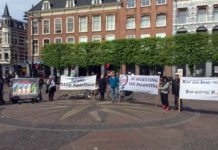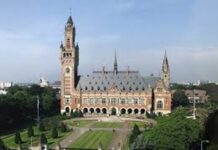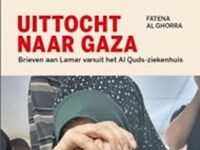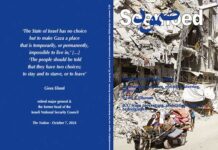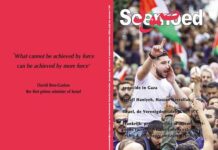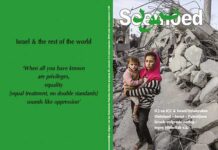Nimo Omer
The Guardian / March 28, 2025
Media workers in Gaza and the West Bank have faced relentless danger, and attacks on press freedom on the rise across the world
More than 170 journalists have been killed in Gaza since 2023, with some estimates putting the toll as high as 206. It is the deadliest conflict for media workers in recent history. In a sobering report, Thaslima Begum gathered some of their stories. And attacks on journalists worldwide are on the rise, with deaths occurring everywhere from the Middle East to Europe.
Just this week, Hossam Shabat, a 23-year-old reporter, was killed in Gaza. Shabat had feared death since Israel accused him of terrorist activity. He had already written a message to be published in the event of his death: “For the past 18 months, I have dedicated every moment of my life to my people. I documented the horrors in northern Gaza minute by minute, determined to show the world the truth they tried to bury … I risked everything to report the truth, and now, I am finally at rest – something I haven’t known in the past 18 months.”
For today’s newsletter, I spoke with Palestinian journalist Hind Khoudary, who has been reporting from Gaza since the start of the war, about the situation on the ground for reporters and Guardian journalist Ruth Michaelson about what is driving the decline in press freedom around the world. That’s right after the headlines.
‘No Palestinian journalist is too high-profile to be targeted or harmed’
This week, two Palestinian journalists were killed in Israeli airstrikes: Al-Jazeera’s Shabat, who died in Beit Lahiya, and Palestine Today’s Mohammed Mansour, who was killed in his home alongside his wife and son. Israeli forces deny targeting journalists, but in this case the IDF confirmed it had deliberately killed both reporters, calling them terrorists. Shabat, widely known for his reporting from northern Gaza, had already rejected such claims when they were first levelled against him in October, calling them part of a “systematic propaganda campaign to justify the unjustifiable”.
Israel has barred foreign journalists from entering Gaza, an unprecedented move in modern times, leaving the task of documenting the violence solely to Palestinian reporters working on the ground without protection. Within months of the war starting, press freedom organisations accused the Israeli military of targeting journalists and their families. In the occupied West Bank and East Jerusalem, reporters face growing hostility from Israeli forces. Human Rights Watch has said the Israeli government “has taken an unprecedented series of steps to curtail media freedom, effectively resulting in the establishment of a censorship regime”.
Life as a journalist in Gaza
Journalists in Gaza are not only working under heavy bombardment. Like every other civilian, they are contending with perilous conditions. Khoudary, who has been displaced in Deir al-Balah in the central Gaza Strip for the past year and a half, does not remember the last time she saw her family, who evacuated to Cairo. “Since then I have been on my own,” she says. “All I want is a hug after a very harsh day. I want to sit on my mother’s lap and hug my brothers. It has been so hard losing everything you own and love. I never thought that I would ever live this in my life.”
Khoudary says the situation has been particularly bad since the collapse of the ceasefire and the renewal of the total blockade of aid. “Journalists have been literally living everything they have been reporting – we have been displaced, starved, dehydrated, not sleeping,” she says. Making things harder, she adds, is the distress of learning that colleagues and friends have been injured or killed.
Shabat’s death was felt particularly acutely because he was one of the few journalists who remained in northern Gaza. “There was an intimacy to his coverage, the way he documented his home and what was happening there, and because of this the outside world had grown to know him,” Ruth says. “The other thing Shabat said was that he felt like he was being hunted, and that is a sentiment we hear time and time again from our colleagues reporting in Gaza – that they feel like they are being singled out for attack.”
The Israeli government has strenuously denied targeting journalists, or has said that those who have been targeted were involved in violent activity.
This is not the first time Israeli authorities have made such claims. Last year they designated six Al Jazeera journalists based in Gaza as members of Hamas and Palestinian Islamic Jihad (PIJ), an allegation the network vehemently denies. The Committee to Protect Journalists has previously condemned Israeli authorities for the “smearing of killed Palestinian journalists with unsubstantiated ‘terrorist’ labels”.
Foreign media have been pressuring the Israeli government to allow them into Gaza, but Ruth points out that this slightly obscures the reality that Palestinian journalists are already reporting for international outlets. Khoudary says Palestinian journalists have been marginalised and neglected: “People have been using us as tools for their media agencies. Most of us don’t have protection gear, we are working with the bare minimum of tools to tell the story.
“Sometimes people forget the fact that we are also humans,” Khoudary continues. “We have been reporting with zero break, no days off, because there is no days off. I just want the world to know that we are very tired and overwhelmed and we do not want to lose more.”
West Bank and East Jerusalem
The attacks on media are not limited to Gaza. In September, Israeli forces raided Al-Jazeera’s office in the occupied West Bank and banned its operations in Israel. And last weekend a German journalist was arrested by Israeli police in the occupied West Bank for allegedly assaulting a settler, despite video footage showing settlers blocking him and acting threateningly. A few days later Oscar-winning director Hamdan Ballal was attacked by settlers and then arrested, in what he says was retaliation for his documentary on the displacement of Palestinians in Masafer Yatta. “As we tragically saw with the killing of Shireen Abu Akleh in 2022, no Palestinian journalist is too high-profile to be targeted or harmed,” Ruth says.
The latest data from the CPJ shows that 75 journalists have been arrested in the Palestinian territories of the occupied West Bank and Gaza, as well as in Jerusalem. In 2024 Israel was added to the list of the “worst jailers of journalists” for the first time and according to the UN, Israeli forces have fired live ammunition at journalists or their vehicles while they were reporting on military operations and civilian casualties. The image that emerges is one of a country deeply hostile to and suspicious of critical coverage, willing to go to great lengths to clamp down on it.
The Palestinian Authority in the occupied West Bank has also mirrored Israeli crackdowns on the press, suspending Al Jazeera from broadcasting due to its coverage of fighting between the PA and Palestinian armed groups. “The PA has a track record of detaining journalists and curbing coverage it doesn’t like,” Ruth says. “It is, unfortunately, not a free media environment, and that is really cutting off visibility to the outside world.”
It’s a problem everywhere
In the past few months alone, the press has faced an onslaught. In the US, the Trump administration has moved to withdraw funding for Radio Free Europe and Voice of America, threatened media outlets with lawsuits, and revoked press credentials of organisations critical of the White House. In Turkey this week, journalists have been arrested and deported. In Indonesia, reporters are facing increasing intimidation, with decapitated pigs and rats being sent to their offices.
Media crackdowns can also take the form of seemingly mundane bureaucratic obstacles. In India, the government has been refusing to renew work permits for some foreign journalists.
“When a journalist is mistreated, it should be an international incident,” says Ruth. “One of the consequences when it isn’t is this increasing climate of impunity towards journalists, which we’ve seen over at least the past decade, since 2012, when Marie Colvin and Rémi Ochlik were killed in Syria.”
Nimo Omer is the assistant editor of The Guardian’s First Edition newsletter


